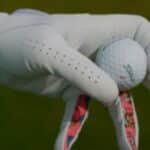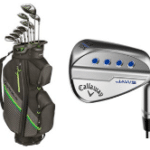If you’re wondering whether it’s time to replace your golf balls, we are fully guiding you to be at least as careful as you would with new clubs.
However, a new golf ball is like oxygen. Without it you cannot function properly, so you need to make sure it is still functional.
So a smart way to start your it search is to ask yourself questions about the way you play and the things that are important to you.
There is no one-size-fits-all approach to golf and a good ball depends on factors like your swing speed and the desired distance you want your ball to cover.
Besides, the perfect golf ball will have certain attributes like spin, compression, and multiple layers. Therefore, selecting the best golf ball requires a thorough understanding of these aspects.
So how do you select the best golf ball for you? Let’s break things down.
Related Post: How To Carry a Golf Bag
How Can I Choose the Best Golf Ball for Me?
Some people opt to get any golf ball type that their preferred golfing winner uses, but this might not always be a good fit. After all, making a simple shift in compression can make all the difference in your presentation on the course!
The following factors to keep in mind while choosing it.
Select the Appropriate Number of Layers:
Break the golf ball down to be able to choose, it can be disassembled into as few as one and as many as five parts. we really intended that.
Typically, a player would increase the number of layers the more knowledgeable they get in the field. Still, any number of layers has advantages and disadvantages.
The number of layers is determined by the spin rate, distance traveled, and shot height. When we said to break down the it so you could select, we meant it. However, any number of layers has advantages and disadvantages.
The number of layers is determined by the spin rate, distance traveled, and shot height. When we said to break down the it so you could select,
When you are taking part in a golf ball, it can consist of anywhere from one up to five pieces. Generally, lower flights and higher spin rates suit golfers with more experience, while beginners would do well with maximum distances, less spin, and high shots.
The ball goes for more distance with less height and more spin. So, choose your golf ball based on your skill level and what kind of performance you want on the course.
Balance Between Compression, Spin, and Distance
While compression may not be as important in golf ball selection as it previously was, it is still worth considering.
Compression, spin rate, and distance are three seemingly independent parameters that are linked by a similar thread. The amount a golf ball compresses upon impact has a direct impact on both its spin rate and the distance it travels.
In principle, more compression reduces distance since the ball launches higher and rolls less, whereas lower compression has the opposite effect.
So, what can you do to remedy this? Begin by assessing your swing speed, and then follow the principles below:
Low swing speed (about 85 MPH):
Choose it with compression ratings less than 70, which It is on the lower end of the scale.
High Swing Speed (about 100 MPH and Above):
Look for golf balls with high compression rates, often 90 or above, since they will better complement your swing speed.
Golfers with a moderate swing speed (85 to 100 MPH):
can find a nice balance with golf balls with low to mid-range compression rates.
Keep Up With the Regulations
If you are playing tournament you should have regulations If you don’t want to risk being eliminated.
The United States Golf Association requires that all golf balls meet particular regulations. According to this , a golf ball must weigh at least 1.620 ounces, have a diameter of at least 1.680 inches, and be absolutely regular.
Any golf ball model that has been changed in a way that deviates from these standards cannot be used.
The United States Golf Association requires that all golf balls follow particular regulations.
Due to these standards, a golf ball must weigh at least 1.620 ounces, have a diameter of at least 1.680 inches, and be absolutely symmetrical. Any golf ball model that has been altered in a way that deviates from these standards cannot be used.
Are Recycled Golf Balls Value a Swing?
Are you thinking about using recycled it for your game? Some brands sell recycled balls that look almost identical to new ones, with the main differences being small imperfections and discolorations.
It is important to remember that recycled golf balls do not have the same durability as new ones, but they are less expensive, making them a good choice for beginners.
Also, they aid the environment by providing a sustainable golfing choice that benefits both your game and the world. As a result, it’s like killing two birds with one stone!
Best balls: what to look for
We’ll start out by saying that there’s no such thing as a “best golf ball”. Because everyone is going to have different needs and preferences.
The best ball for a 70-year-old senior is obviously going to be different than the best golf ball for a scratch golfer, or a beginner. And do you really need to spend $50 or more on a box of golf balls?? Probably not.
When choosing the it,we recommend you look at three different things:
- Skill Level
- Swing Speed
- Budget
Types of golf balls for the stages of your golfing journey
here’s a shorter summary of the five types of golf balls:
One-Piece Balls:
These are basic golf balls made from a single material, like Surly. They are tough and durable but lack spin. They are mostly used in mini-golf and driving ranges.
Two-Piece Balls:
More common than one-piece balls, they have a rubber core and a Surly or urethane cover. They offer durability and distance, making them suitable for beginners.
Three-Piece Balls:
These balls strike a balance between feel and distance. They are favored by serious golfers and professionals for their performance and spin control.
Four-Piece Balls:
These balls have an extra layer, aiming for “spin separation.” They may benefit golfers with faster swing speeds, offering reduced spin with drivers and increased spin with short irons.
Five-Piece Balls:
The most complex golf balls, offer intricate spin control. They are designed to provide both distance and spin control for experienced golfers. The science is much the same as four-piece It; these extra layers allow for more spin separation and less compression for overall better performance. These are usually premium golf balls, so take this added expense into consideration .
Related Post: 8 Ways How To Arrange Golf Clubs
How to test out a new type of golf ball
To determine the best golf ball
Test a Variety:
Try one sleeve of each ball type at practice stations.
Create Evaluation Stations:
Focus on short and long pitches and chips.
Maintain Consistency:
Hit from the same area for each ball.
Consider Conditions:
Account for weather conditions, as wind can affect comparisons.
Listen to Impact:
Pay attention to the sound of impact between your club and the ball.
Play on Course:
After testing, select suitable options and play on the course for further evaluation.
Think about
· Your swing speed
· Your ability
· Your areas for improvement
· Your budge
Best ball for you:
consider when selecting a golf ball, the next step is to choose the right one for your game. Finding the specifications of each ball is straightforward; you can easily check the manufacturer’s website or refer to our golf ball information chart.
Keep in mind that individual preferences may vary, but this will serve as a helpful starting point.
Beginner Golfer:
Beginners tend to lose a significant number of golf balls, so price becomes a crucial factor. It’s not practical to use expensive balls when you’re losing several per round.
Therefore, opt for an affordable ball designed for distance and a straight, high trajectory. You can find our recommended golf balls for average golfers in the list below.
High Handicap Golfer:
High handicap golfers, who are considered average and still lose a fair number of balls each round, should also prioritize cost-effectiveness. Premium balls may not provide significant benefits at this stage.
Instead, focus on a forgiving ball with low driver spin, which can help you hit more fairways and lower your scores. Check our list for the best golf balls suited for average golfers.
Mid Handicap Golfer:
As your skills improve, you’ll likely want more from your golf ball. At this point, you can control the trajectory and even the amount of spin on your wedge shots.
Look for a ball with a bit more spin while ensuring it remains low-spin with the driver. A ball with moderate short-game spin is the right choice. Explore our list of the best golf balls for mid-handicappers to find suitable options.
Senior golfer:
as a senior player you should try to be a cut golfer or you try to shoot somewhere close to 100.
One thing you should keep in mind is that your swing speed decreases. You should start playing a ball with a lower compression rating.
if you have a high handicap, go with low compression and low spinning ball. If you are mid-handicap, go with a low compression and higher spinning ball.
Related Post: Best Golf Bags for Push Carts
Conclusion:
Choosing the best golf ball may appear simple, but it is a more complex process than you may believe. It come in a variety of styles and have a variety of features and skills.
This article should have thrown some light on the aspects to consider when selecting a golf ball. However, unless you start hitting drill shots, you won’t truly know which golf ball is best for your game.
Experiment with many ball variations to make an informed decision. Begin by purchasing a few different varieties and practicing with them.
This hands-on approach will expose the unique characteristics of each ball and assist you in determining which one best suits your playing style.
FAQS.
1. What factors should I consider when choosing golf balls?
Answer: When choosing a golf ball, consider the following factors:
- Skill Level: Beginners may benefit from using two-piece golf balls, which are more durable and provide more distance. Advanced players might prefer multi-layered balls for better control and spin.
- Swing Speed: Golfers with slower swing speeds might choose softer balls for better compression and distance. Those with faster swing speeds might opt for firmer balls to maximize control.
- Feel: Some golfers prefer a softer feel for more feedback and control around the greens, while others might like a firmer feel for added distance.
- Budget: Golf balls come in a range of prices. Higher-end balls offer advanced features but can be more expensive. Determine your budget and find a balance between cost and performance.
- Playing Conditions: Consider the typical weather and course conditions where you play.
2. What are the differences between two-piece and multi-layer golf balls?
Answer: The main differences between two-piece and multi-layer golf balls are:
- Construction: Two-piece golf balls consist of a solid rubber core and a durable cover, making them simpler and often more durable. Multi-layer balls have multiple layers, including a core, mantle layers, and a cover, allowing for more advanced performance characteristics.
- Distance vs. Control: Two-piece balls are generally designed for maximum distance and durability, making them ideal for beginners and high-handicap golfers. Multi-layer balls offer more spin and control, which can benefit advanced players who prioritize shot-shaping and feel.
- Feel: Two-piece balls typically have a firmer feel, while multi-layer balls can provide a softer feel, especially around the greens.
- Cost: Two-piece balls are usually more affordable, while multi-layer balls are more expensive due to their advanced construction and performance benefits.
3. How does compression affect golf ball performance?
Answer: Compression refers to how much the golf ball deforms upon impact with the club. It affects performance in several ways:
- Distance: Lower compression balls (softer) can compress more easily, helping players with slower swing speeds achieve more distance. Higher compression balls (firmer) are better suited for faster swing speeds, as they can transfer more energy for greater distances.
- Feel: Lower compression balls often feel softer, providing more feedback and control around the greens. Higher compression balls can feel firmer, which some players prefer for added distance.
- Control: Lower compression balls can offer more spin, which helps with control and shot shaping. Higher compression balls tend to have less spin, promoting straighter shots.
- Weather Conditions: Lower compression balls can perform better in cold weather, whereas higher compression balls might feel too hard and lose distance.
4. Are there specific golf balls recommended for beginners?
Answer: Yes, there are specific golf balls that are often recommended for beginners:
- Two-Piece Balls: These balls are generally more durable and provide good distance, making them ideal for beginners who may lose balls more frequently
- Low Compression Balls: These balls are designed to maximize distance for players with slower swing speeds
- Affordable Options: Beginners might prefer to choose more affordable balls as they develop their skills and might lose balls more often







